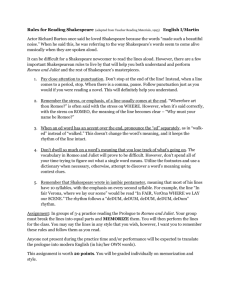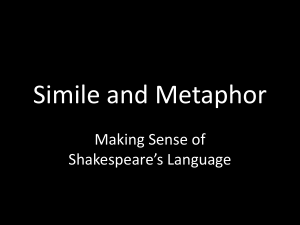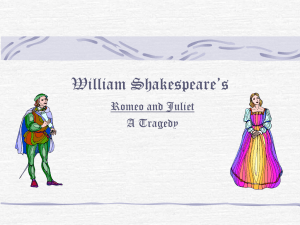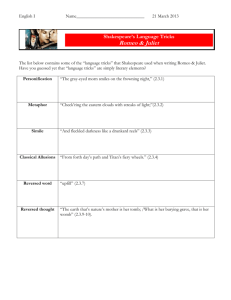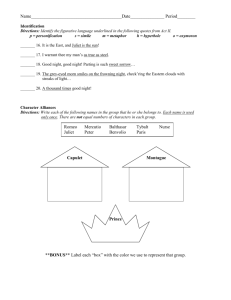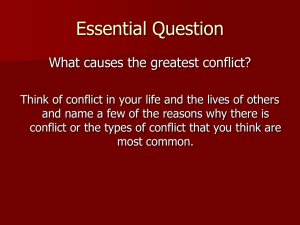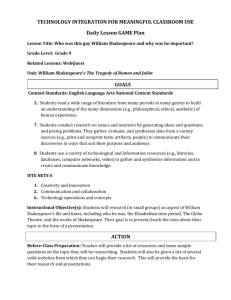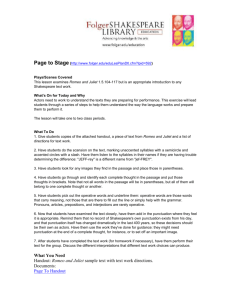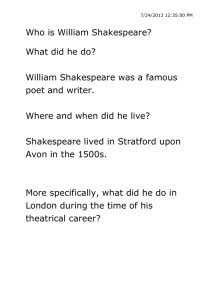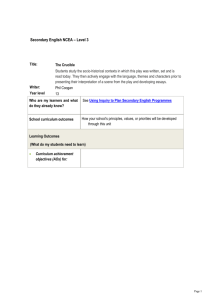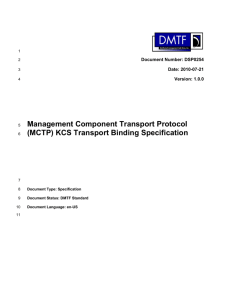Violent Delights and Violent Ends - Romeo and Juliet
advertisement
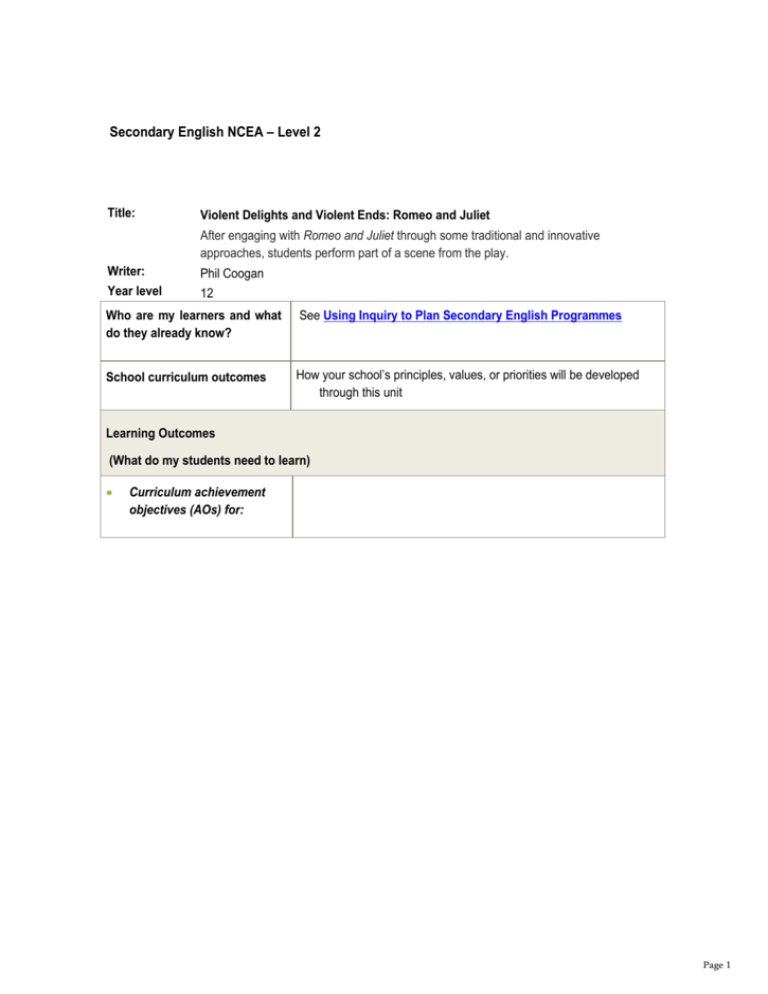
Secondary English NCEA – Level 2 Title: Violent Delights and Violent Ends: Romeo and Juliet After engaging with Romeo and Juliet through some traditional and innovative approaches, students perform part of a scene from the play. Writer: Phil Coogan Year level 12 Who are my learners and what do they already know? See Using Inquiry to Plan Secondary English Programmes School curriculum outcomes How your school’s principles, values, or priorities will be developed through this unit Learning Outcomes (What do my students need to learn) Curriculum achievement objectives (AOs) for: Page 1 English Processes and strategies Integrate sources of information, processes, and strategies purposefully, confidently, and precisely to identify, form, and express increasingly sophisticated ideas. thinks critically about texts with understanding and confidence creates a range of increasingly coherent, varied, and complex texts by integrating sources of information and processing strategies Ideas Select, develop, and communicate sustained ideas on a range of topics. develops, communicates, and sustains increasingly sophisticated ideas, information, and understandings Language features Select and integrate a range of language features appropriately for a variety of effects. uses a wide range of oral, written, and visual language features fluently and with control to create meaning and effect and to sustain interest Structure Organise texts, using a range of appropriate, coherent, and effective structures. organises and develops ideas and information for a particular purpose or effect, using the characteristics and conventions of a range of text forms with control. ● Achievement Standard(s) aligned to AO(s) In 2011: AS 90374: Deliver a presentation using oral and visual language techniques. From 2012: AS 2.6 Create a crafted and controlled visual text Page 2 Teaching and Learning (What do I need to know and do?) 1-2 related professional readings or links to relevant research Using inquiry to plan secondary English programmes English Teaching and Learning Guide [available from February 2011] Conditions of Assessment Guidelines Page 3 Learning task 1 – Pre Reading Learning task 1 Learning intention(s) Establishing prior learning and linking it to the text Shakespeare’s World 1. To find out more about Shakespeare and his world, students are allocated research [link to new resource to be inserted] in small groups This activity will be facilitated by alerting the librarian to the research needs of the KCs/ Principles/Val ues focus KCs: Thinking group well before the activity is to take place. The – explore texts research questions differ in their degree of difficulty and should be allocated accordingly. Students report back to the class the results of their research findings in mini seminars, using visual aids wherever possible. Shakespeare's Theatre 2. Students investigate how the play would have been performed originally by reading information about the Globe Theatre, or viewing the original de Witt drawing of 'The Swan'. Engaging with key ideas in contemporary settings 3. In groups develop a role play based upon one of the situations below. All have links to Romeo and Juliet. The aim is to get you thinking about some of the issues in the play before reading it. After your role play stay in role so that your classmates and teacher can question you. Construct a short role play based upon the following situations: o A teenage boy thinks he's in love with a girl with whom he has been going out for some time. He's always telling his friends how in love he is. A new girl joins his class. She is beautiful. What happens? o A teenage girl has just met a boy she considers to be wonderful. However, she knows that because of his background and the fact that he comes from a family they disapprove of, they would be violently horrified if they ever caught them together. She is in her bedroom at night, thinking out loud about this Page 4 Learning task 2 - Reading Learning task 2 Learning intention(s) Examining key text aspects Learning Log/Journal 1. Choose either Romeo or Juliet. After each class working on the play make an entry in role in your learning log which traces your character's changing feelings and experiences through the play. This entry should be KCs/ KCs: Thinking Principles/Va –using a range lues focus of thinking strategies to build understandings Relate to others – peer discussion Participating and contributing – contributing to a group performance written in role: ie, from the point of view of Romeo and Juliet. It is a sort of diary of events, issues and feelings as experienced by one of the main characters. Not only will this help you develop an understanding of your chosen character, but it will help you remember the plot of the play. Each entry should: include a brief summary of events as experienced by your character. reflect your character's changing emotions in response to these events. reflect your characters changing understanding of the world in which they live. reflect your character's changing feelings towards other characters. Every 3-4 periods, form pairs with a ‘Romeo’ and a ‘Juliet’ and share journal entries. Drama games 2. Use a variety of drama games to highlight points, deepen understanding and increase enjoyment of the play: CIRCLE GAME ONE One person stands in the centre, the rest in a circle. The one in the centre begins to walk towards another person, arms outstretched in their direction. The person being pointed out must say a quote from the play before the centre person gets there or they go in the centre. (Use the quotations resource) CIRCLE GAME TWO Page 5 Learning task 3 Learning intention(s) Preparing and delivering an oral presentation Learning task 3 – Post Reading After the play has been 'read' in the ways outlined, engage in a number of activities to heighten appreciation and deepen understanding prior to preparing for the assessment activity. Character experts KCs/ Principles/ Values focus KCs: Use language, symbols and texts – structure and express understandings about texts Participating and Contributing – contribute to a group performance 1. Form groups of character 'experts' who will be questioned in role after they have had a chance to come to some agreed positions on key features of the character. Prior to being questioned by the class groups need to arrive at a consensus on questions such as those below. They need to be able to provide specific supporting evidence from the text for their agreed position on: o The sort of person the character was at the beginning of the play? What were they like at the end? What caused the changes? Can you point to a key turning point? o What was the moral low point, the moral high point for this character? o To what degree was the character responsible for this tragedy. o What should this character have done differently? o How would this character dress? What general style of clothing would suit? What colours would best represent the character and why? o Agree upon one hand prop (eg. sword, wine goblet, piece of jewellery) which you would have this character use often or be associated with in a production of the play. Contrast in the play 2. In pairs explore the use of contrast in the content of the play, for example: o Capulet - Montague Page 6 Learning task 4 Learning intention(s) Learning task 4 – Additional Resources William Shakespeare: The Complete Works This is a very comprehensive site with links to the complete works Extending learning including background information, biographical information and pictures, information about Elizabethan theatres, a Shakespearean dictionary, the first folio, quotes, a quiz and a discussion forum KCs/ Principles/ Values focus KCs: Thinking – explore texts Surfing with the Bard Cliffnotes Quiz Much Ado About Something Artsedge:Romeo and Juliet In Search of Shakespeare A PBS resource to support the television series which includes, teaching resources, a playwright game and information on Shakespeare's life and times. Converse: Shakespearean Resources Some excellent interactive resources to support the study of Shakespeare, including an animated depiction of the experience of viewing a Shakespearean play, an interactive 3D version of the Globe,plot questions on several plays, Shakespeare's insults and more. No Fear Shakespeare A site which presents the language of Shakespeare's plays side-by-side with a facing-page translation into modern English. This unit could lead into (or be substituted by) a film study of either or both the Zeffirelli (1968) or the Lurhman (1997) films based on the play. Many of the activities in the English Level 2 Assessment Guide would be particularly suitable for this. A useful introductory resource is Shakespeare Illustrated - a selection of paintings and drawings based upon Romeo and Juliet. Page 7 Assessment and Evaluation (What is the impact of my teaching and learning?) Formative and/or Summative assessment task(s), including how will feedback be provided In 2011: AS 90374: Deliver a presentation using oral and visual language techniques. From 2012: AS 2.6 Create a crafted and controlled visual text Provision for identifying next learning steps for students who need: This piece of writing should be an integrated part of the year’s writing programme. Refer to - further learning opportunities English Teaching and Learning Guide [available from February 2011] - increased challenge Conditions of Assessment Guidelines for oral presentations. for more details. Tools or ideas which, for example See: Using inquiry to plan secondary English programmes might be used to evaluate: - progress of the class and groups within it - student engagement leading to : - changes to the sequence - addressing teacher learning needs Page 8
